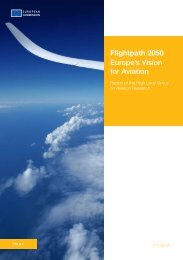Create
Final Report - Acare
Final Report - Acare
- No tags were found...
You also want an ePaper? Increase the reach of your titles
YUMPU automatically turns print PDFs into web optimized ePapers that Google loves.
THE IDEAS<br />
IV.<br />
in mid air. One envisaged a very large toroidal<br />
shaped LtA vehicle carrying the fuel reserves.<br />
Its toroidal shape would be designed to allow it<br />
to rotate whilst maintaining a fixed geographic<br />
station. This rotating feature was thought to<br />
allow airliners to engage with the refuelling<br />
booms whilst flying a circular path. The other<br />
idea had a large airship or Zeppelin carrying<br />
fuel reserves and flying on a circuit such that<br />
airliners could engage with the fuel booms in<br />
flight. Both ideas incorporated designs aimed<br />
at alignment of the fuelling aircraft speed with<br />
the boom speed from the LtA.<br />
An alternative would be a fleet of UAV tanker<br />
aircraft based around a large airship fuel<br />
base. The mother-ship would cruise around a<br />
defined orbit maintaining a speed sufficient<br />
for the UAVs to dock with its replenishment<br />
booms. The maximum speed for airships is less<br />
than 100 mph so the UAVs would need to be<br />
able to fly to the booms at speeds perhaps<br />
as low as 85-90 mph and then also dock with<br />
airliners travelling at something like 50%<br />
faster (order of 80 knots for the airship up to<br />
120+ knots for the airliner).<br />
The challenges for the UAVs were seen to<br />
be their macro flight paths – moving from<br />
the airship to join the refuelling path of the<br />
airliners – and their micro paths – controlled<br />
and automatic docking with both types of<br />
air vehicle. The UAVs would need to be large<br />
aircraft in their own right. The top-up fuel<br />
for a long intercontinental flight for an A380<br />
airliner would be about 250,000 litres. Even<br />
if this was divided into 2 or 3 deliveries the<br />
minimum tanker size would be of the order of<br />
100,000 litres of dispensed fuel. This indicates<br />
an aircraft of about A320 size for the UAV.<br />
The largest challenge remains the use of the<br />
airship mother-vehicle. Topping up a stream<br />
of airliners with a take off frequency from<br />
a large hub of perhaps 40 per hour implies<br />
a very large refuelling operation even if<br />
divided among several airships. The mission<br />
endurance of the airship would need to be<br />
several hours and might amount to a total<br />
payload perhaps of the order of 10,000 tons,<br />
massively greater than any airship to date. For<br />
an airship dispensing this very large load at a<br />
rate of perhaps 15 tonnes per minute imply<br />
enormous stability and control issues. Devices<br />
exist to stabilize the lifting capacity of airships<br />
as weight is transferred by pumping and<br />
compressing or expanding gas from the liquid<br />
state to gas or reverse. It is not known what<br />
size such a system would need to be to cope<br />
with the rate of discharge but the amount<br />
of gas that would need to be compressed to<br />
compensate for fuel discharge would evidently<br />
be of the same order as the weight of fuel.<br />
This gas management system would therefore<br />
occupy a weight and volume comparable to<br />
the fuel storage and discharge system.<br />
Fig.23.<br />
Artist’s impression of<br />
mid air refuelling of civil<br />
airliners<br />
69



